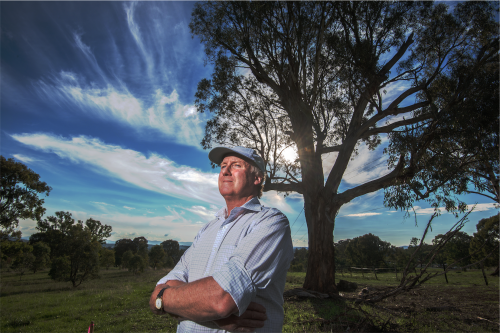
Now they are angry and bewildered. Their adopted park and the work they have done to restore it have been used to justify the destruction of a neighbouring patch of the same critically endangered native woodland.
Since 2012, federal environmental policy has required a separate piece of land be reserved as a “biodiversity offset” for developments that consume pieces of dwindling native habitats, but critics say the policy is being deliberately misapplied in the ACT by both the Federal and Territory governments.
Justice Robert Hope Park is in the category of “White Box-Yellow Box-Blakely’s Red Gum Grassy Woodland”, listed as critically endangered by the federal Department of the Environment, and has been used as a biodiversity offset to make up for the loss of the same woodland type next door.
“Our first gripe is the area they have chosen as an offset is already a reserve… and to me, that is completely wrong,” says ecologist John Briggs, from Watson Community Association’s Woodlands Working Group.
Briggs heads up the south-east region Ecosystems and Threatened Species Team in the NSW Office of Environment and Heritage, Flora and Vegetation Management Unit. He was the one who first assessed the land and confirmed its conservation value for the locals who wanted to save it.
“The Commonwealth policy says that an area that’s already a reserve shouldn’t be eligible, and neither should an area that can’t be built on, because of current zoning or whatever reason, yet they’ve let this go through,” he says.
“And, they’ve used the improvements to the condition of the park that were done by the community group as part of the justification. They’ve used our work to subsidise the environmental costs of this.”
Briggs is not alone in this view. Dr Philip Gibbons, a senior lecturer at the ANU with expertise in conservation, biodiversity, environment policy, landscape ecology and natural resource management, and ANU biologist Prof Jochen Zeil, the convenor of Friends of Mount Majura, wrote much the same thing in “The Canberra Times” in January.
They argued that using existing reserves such as Justice Robert Hope Park as biodiversity offsets, as the ACT Government and the Commonwealth believe they can be, is “in clear contravention” of “a key principle” behind the policy.
On March 28, the Land Development Agency (LDA) sold Block 9, Section 64 North Watson, for $7.3 million “to be developed as a sustainable precinct” with 80 to 110 new homes, which will require a 10m-wide clearing for a stormwater pipeline through the woodland reserve next door and another 100m-wide section carved off as an “outer asset protection zone” for bushfire safety.
“I’m really disappointed that the ACT government has taken such a ruthless view to our efforts there, and that they’re allowing these impacts to the park such as the asset protection zone and the pipeline that’s going to knock down our eight-year-old plantings,” says Briggs, who believes both impacts could have been avoided.
In 2001, the public campaign to save the park on Canberra’s north-eastern fringe found support in the Legislative Assembly from independent and Greens MLAs, as well as Labor, in opposition at the time.
“If you allow any development within the site… the site cannot regenerate as an intact unit of Yellow Box/Red Gum grassy woodland. It cannot be done,” then-opposition MLA Simon Corbell told the tree planters at a rally in 2001.
“[…] The Labor Party has taken the view that the only way to ensure its integrity in the long term is to protect it in its entirety, and that is the Labor Party’s position.”
Half a year later Corbell was Planning and Land Management Minister in the Stanhope Government, which gave Justice Robert Hope Park a level of protection that left a 70 per cent chance of it being destroyed at some point, at least according to the Department of the Environment’s recent assessment of its potential as a biodiversity offset.
“Back then we were very positive and very grateful to Simon for that support,” recalls Briggs, wondering if their former champion, who he says now refuses to meet the group in person, has been “caught in the middle of politics” and rolled by the powerful LDA.
“I’m extremely disappointed that Simon hasn’t supported its full protection now. I just feel it’s about money, that they’re desperately looking for revenue and they don’t care about anything else.”
More information including public submissions and the government’s responses at: economicdevelopment.act.gov.au/community_engagement/current_activities/block-9-section-64-watson
Who can be trusted?
In a world of spin and confusion, there’s never been a more important time to support independent journalism in Canberra.
If you trust our work online and want to enforce the power of independent voices, I invite you to make a small contribution.
Every dollar of support is invested back into our journalism to help keep citynews.com.au strong and free.
Thank you,
Ian Meikle, editor




Leave a Reply